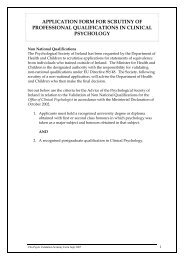Brennan Report - Department of Health and Children
Brennan Report - Department of Health and Children
Brennan Report - Department of Health and Children
Create successful ePaper yourself
Turn your PDF publications into a flip-book with our unique Google optimized e-Paper software.
Chapter 5 Accountability – Hospital <strong>and</strong> Non-Hospital ProgrammesThe table above illustrates that for the larger (Group 1) hospitals, the economic cost per bedday increased by ¤ 81 from 2001 to 2002 (from ¤ 465 to ¤ 546). However, the private patientcharge for that bed day increased by just ¤ 7.As a result, the inpatient bed-day subsidy increasedby ¤ 74 in just one year (from ¤ 233 to ¤ 307).The table shows that there is a similar outcomein the smaller (Group 2) hospitals with the nominal subsidy increasing by ¤ 57 year on year.Thisoutcome for 2000/2001 is inconsistent with Government policy. 7TransparencyWe believe that the taxpayer is entitled to know how much <strong>of</strong> his/her contribution to taxrevenues is being spent on private patients in public hospitals. The full costs <strong>of</strong> treating privatepatients in public hospitals should be both transparent <strong>and</strong> publicly available. This reflects ourcore principle on patient costing i.e. that all costs incurred should be capable <strong>of</strong> beingallocated to individual patients.The benefit <strong>of</strong> making this information publicly available is that it would inform the policy debate<strong>and</strong> allow consideration <strong>of</strong> the real costs <strong>and</strong> State subsidies associated with the public/privatemix. A further argument for making any subsidy explicit is that significant hidden subsidies <strong>of</strong>the treatment <strong>of</strong> private patients in public hospitals may inhibit the development <strong>of</strong> privatefacilities that may be competing with private medicine carried out in public hospitals.Recommendations on Public/Private Mix in Public HospitalsR5.20 All Service Plans, Practice Plans <strong>and</strong> monthly, quarterly <strong>and</strong> annual reports should include a clear breakdownbetween public <strong>and</strong> private costs <strong>and</strong> activities.R5.21 A coding system should be put in place in all cases (e.g. outpatient activity, private patients having tests in apublic hospital etc.) <strong>and</strong> in all hospitals to explicitly identify all activity as relating to public or private patients, asappropriate.R5.22 The coding system referred to at R5.21 above should allow for allocating <strong>of</strong> general overheads incurred byhospitals between public <strong>and</strong> private patients so that the full cost <strong>of</strong> treating public <strong>and</strong> private patients can becalculated. The objective should be to identify the costs <strong>of</strong> treating individual patients.R5.23 The Executive should publish in its Annual <strong>Report</strong> a comprehensive analysis <strong>of</strong> the amount <strong>of</strong> public resources 8consumed by private patients within the public hospital sector.R5.24 Recognising that implementation <strong>of</strong> the information systems recommended in Chapter 10 will be necessary toproduce accurate information in respect <strong>of</strong> R5.23 above <strong>and</strong> the lead in time for the establishment <strong>of</strong> theExecutive, the <strong>Department</strong> <strong>of</strong> <strong>Health</strong> <strong>and</strong> <strong>Children</strong> should, on an interim basis, publish such information using thebest estimates that are available to it.R5.25 The provisions <strong>of</strong> Consultants’ existing common contract should be enforced to ensure that the following isundertaken:(i) The setting <strong>of</strong> core times when a Consultant must be available to patients in the public hospital; <strong>and</strong>(ii) Formal active monitoring <strong>of</strong> work commitment in respect <strong>of</strong> public patients.R5.26 The health board/hospital CEO should put mechanisms in place to ensure;(i) Consultants’ sessional contractual commitments to the public hospital are met; <strong>and</strong>(ii) The cap on private activity in public hospitals is observed both with respect to inpatients <strong>and</strong> day-cases(i.e. agree with Consultants on the number <strong>of</strong> private patients to be treated in public hospitals).7One <strong>of</strong> the recommendations <strong>of</strong> the “White Paper on Private <strong>Health</strong> Insurance” (1999) was that the gap between the charges forprivate patients <strong>and</strong> actual costs should be eliminated over a 5 to 7 year period.8At a minimum this should include direct public expenditure within the health sector.The <strong>Department</strong> <strong>of</strong> <strong>Health</strong> <strong>and</strong> <strong>Children</strong> shouldconsider the extent to which other costs, such as tax relief <strong>and</strong> medical teaching costs, should also apply.73
















